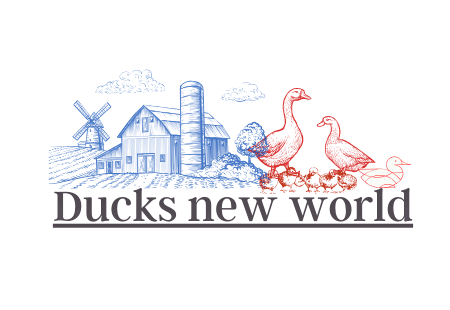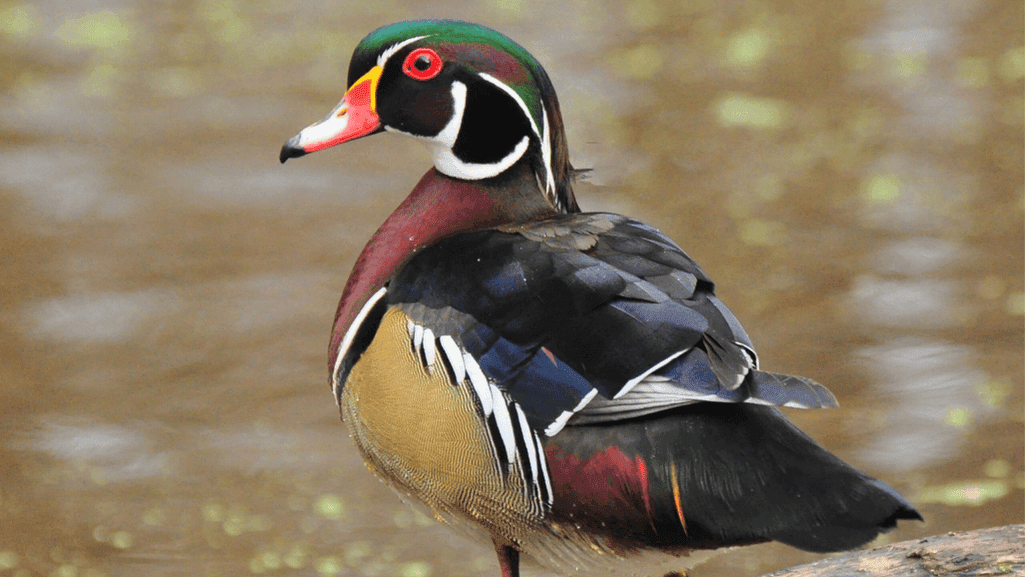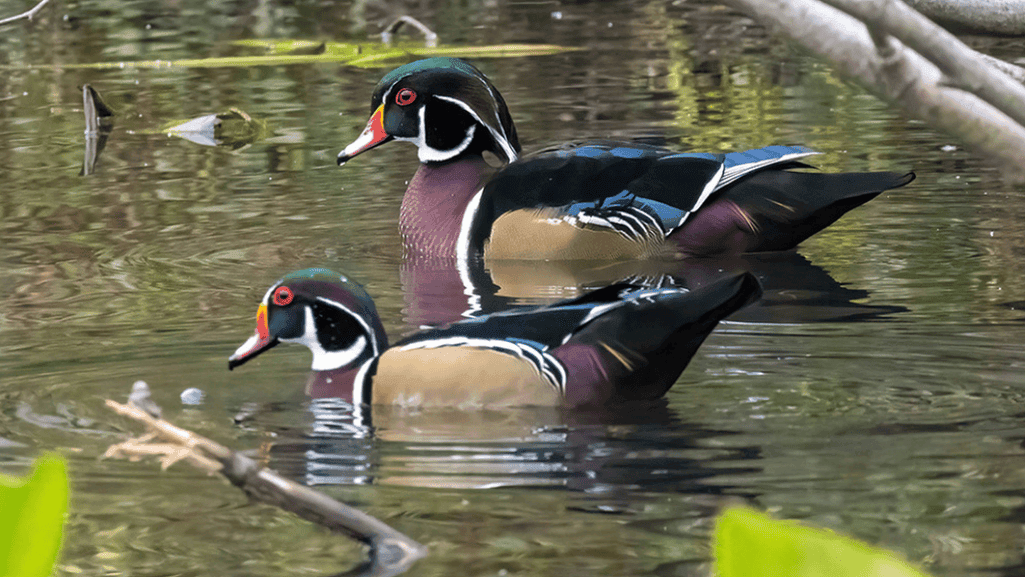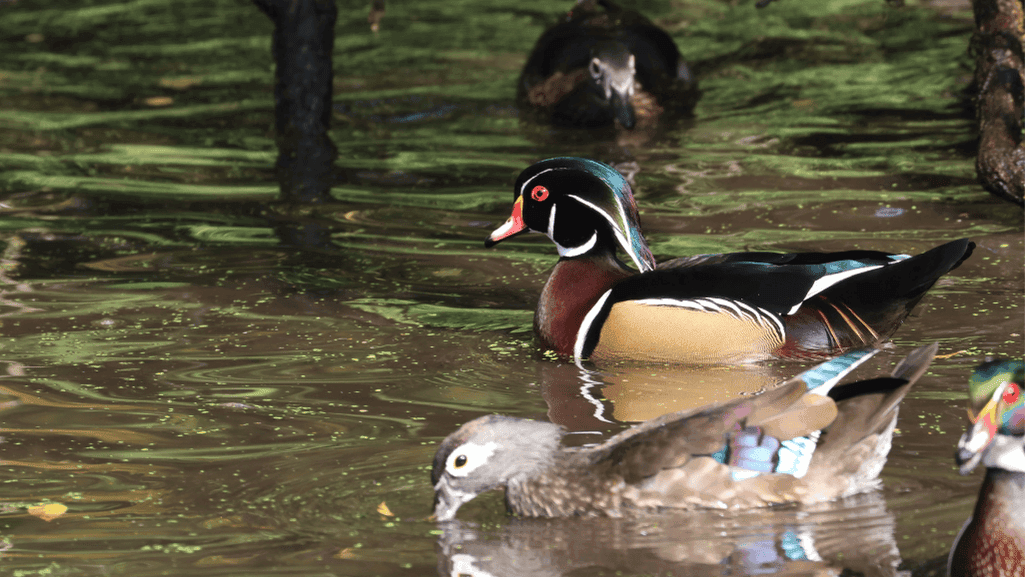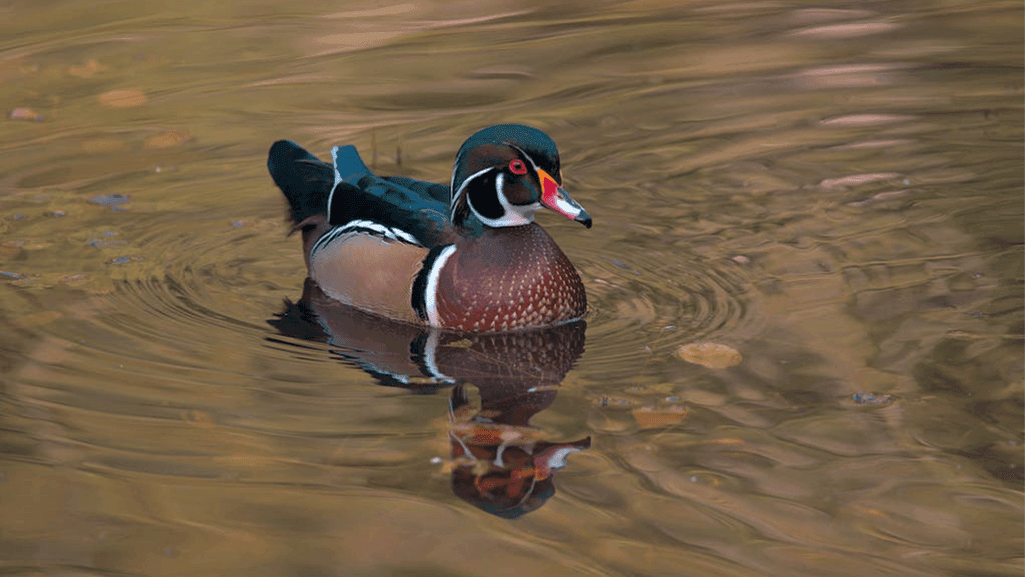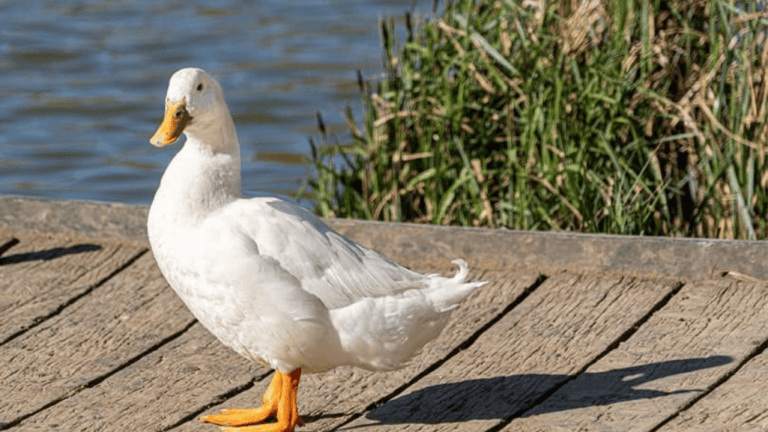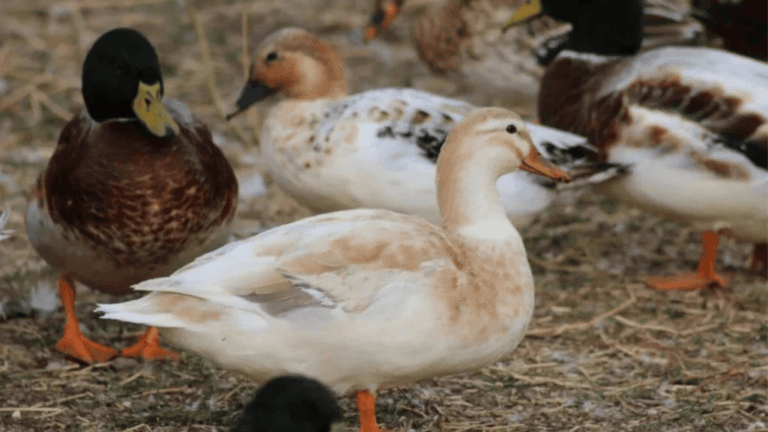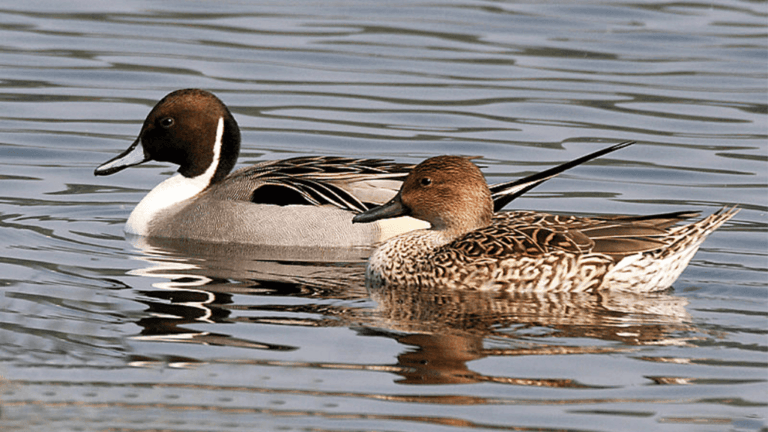Get ready to be amazed by the Wood Duck (Aix sponsa), a migratory bird known for its stunning colorful plumage. This bird is a cavity nester, finding homes in tree holes near water. It’s a sight to behold in wetland habitats across the United States, southern Canada, and western Mexico.
Wood Ducks are more than just a pretty sight. They help keep the balance of life in our waters. They’ve even learned to use nesting boxes made by humans, which is key to their survival. By eating insects and spreading seeds, they help their homes stay healthy.
Key Takeaways:
- Wood Ducks are among the most visually stunning waterfowl species in North America
- Their colorful plumage sets them apart from other duck species
- Wood Ducks are cavity nesters, seeking refuge in tree holes and man-made nesting boxes
- Conservation efforts, such as providing nesting boxes, have helped Wood Duck populations rebound
- Wood Ducks play a crucial role in maintaining the balance of aquatic ecosystems
Introduction to the Wood Duck: A Feathered Gem
https://www.youtube.com/watch?v=iKWxhrXuEOA
Get ready to be amazed by the Wood Duck (Aix sponsa). This bird is a true work of art, with bright colors and special behaviors. You’ll learn how Wood Ducks are important in their ecosystems and their interesting nesting habits.
Enchanting Waterfowl Species of North America’s Wetlands
Wood Ducks are a joy to see in North America’s wetlands. They live in wooded swamps, marshes, and lakes. Their love for woodlands makes them unique and loved by many.
Ducks New World celebrates ducks like the Wood Duck. They teach people about these birds and help protect them.
Vibrant Colors and Unique Behaviors
The Wood Duck’s colors are amazing. Males have green and blue feathers with bold stripes. They also have red eyes and a special white face.
Females are beautiful too, with white teardrops and a warm brown body. Wood Ducks are special because they perch and nest in trees.
During courtship, males show off by bobbing their heads and raising their crests. This attracts females.
Role in the Ecosystem and Nesting Habits
Wood Ducks are key to their ecosystems. They eat insects and help plants grow. Their nesting habits are also important for conservation.
Wood Ducks nest in tree cavities or boxes. Females lay up to 15 eggs. The ducklings leap from the nest to the ground or water, showing their strength.
Groups like Ducks Unlimited work hard to protect Wood Ducks. They create habitats for these birds. This ensures they can thrive for years to come.
The Evolutionary Artwork of Plumage: Why Wood Ducks Stand Out
In the world of waterfowl, the Wood Duck is unmatched in beauty and plumage patterns. Their colors and designs are not just stunning but also crucial for survival and reproduction. The Wood Duck’s plumage shows the power of natural selection and the role of visual cues in the animal kingdom.
Flamboyant Feathers and Mating Success
The Wood Duck’s feathers are key in attracting mates and ensuring reproductive success. Male Wood Ducks have vibrant colors and patterns that show their health and genetic fitness. The more striking a male’s plumage, the better his chances with females.
Females are naturally drawn to males with the most impressive displays. These visual cues indicate a strong, healthy mate. This selection pressure has made the Wood Duck’s appearance more spectacular over time.
Varied Hues, Complex Patterns, and Year-Round Display
The Wood Duck’s plumage is known for its variety of colors and patterns. Unlike many ducks, Wood Ducks show a wide range of hues. From the male’s iridescent greens and purples to the intricate patterns on his breast, each feather tells a story of evolutionary artistry.
The Wood Duck’s plumage is not just stunning but also complex. Each feather has spots, stripes, and splashes of color that create a mesmerizing tapestry. These patterns are carefully crafted to maximize the bird’s attractiveness and visual impact.
Another unique aspect of the Wood Duck’s plumage is its year-round display. While many ducks change their appearance during the non-breeding season, Wood Ducks keep their colors all year. This allows them to remain visually striking and attractive to potential mates even outside the breeding season.
To learn more about the fascinating world of Wood Ducks and their captivating plumage, visit this informative article that delves deeper into the beauty and biology of these remarkable birds.
A Palette of Colors: Examining the Wood Duck’s Colorful Plumage
The wood duck, native to North America, is a true marvel of nature. It sports a stunning array of colors that captivate the eye and ignite the imagination. This magnificent waterfowl, scientifically known as Aix sponsa, boasts a plumage that resembles a masterful painting, with each feather contributing to the overall composition of beauty.
The male wood duck is a sight to behold. Its iridescent head feathers dance with shades of green and purple, shimmering in the light like precious gems. Distinctive white stripes run across their face, curving with architectural precision and framing their eyes, adding a touch of sophistication to their already dapper appearance.
As one’s gaze travels down the wood duck’s body, the visual feast continues. The flanks showcase an intricate pattern of rich chestnut feathers, bordered with delicate white markings that resemble the finest lace. These bold stripes and vivid flanks create a striking contrast, making the wood duck stand out among its waterfowl peers.
Hidden beneath their wings are subtle hues of blue and green, waiting to be discovered by the keen observer. These colors, though less prominent, add depth and complexity to the wood duck’s plumage, like a hidden layer in a painting that rewards those who take the time to look closer.
Even the wood duck’s feet contribute to its colorful ensemble, sporting bright orange hues that complement the rest of its feathers. This attention to detail in every aspect of the wood duck’s appearance is a testament to nature’s impeccable design.
While the male wood duck steals the show with its vibrant colors, the female wood duck possesses a more understated beauty. Her mottled brown, white, and warm tan feathers create a muted palette that provides excellent camouflage in the bird’s natural habitat. This adaptation allows the female to blend in with her surroundings, ensuring her safety and the protection of her offspring.
The wood duck’s colorful plumage is not just a feast for the eyes; it also serves a purpose in the bird’s life. The vibrant colors of the male help him attract a mate during the breeding season, which typically occurs between February and July. The female’s muted colors, on the other hand, help her remain undetected while nesting and caring for her young.
Observing the wood duck in its natural habitat is an unforgettable experience. These birds are most active during early morning and late afternoon, when they can be seen foraging in marshes, wooded swamps, and along the edges of freshwater lakes. To learn more about the spectacular wood duck and its colorful, one can turn to resources such as the Ducks Unlimited website, which offers a wealth of information and stunning photographs of this remarkable species.
In conclusion, the wood duck’s colorful plumage is a testament to the breathtaking beauty that can be found in the natural world. From the iridescent hues of the male’s head to the intricate patterns on their flanks, every aspect of the wood duck’s appearance is a work of art. By appreciating and protecting these magnificent creatures, we ensure that future generations will have the opportunity to marvel at the wood duck’s colorful plumage and the many wonders of the wild.
Sexual Dimorphism in Wood Ducks: Contrast Between the Sexes
Wood Ducks show a striking difference between males and females. This difference in looks shows how nature shapes their survival and breeding ways.
Male Wood Duck’s Stunning Array of Colors
Male Wood Ducks, or drakes, are the most colorful ducks in North America. Their feathers are a mix of green, purple, and chestnut. During breeding season, their colors get even brighter, making them a stunning sight for attracting mates.
Female Wood Duck’s Elegant, Mottled Brown Plumage
Female Wood Ducks, or hens, have a more subtle beauty. They have brownish-olive feathers with white streaks on their breasts. They also have dark eyes and a white eye ring. Their colors help them blend in, protecting them from predators while they nest.
Roles of Sexual Dimorphism in Survival and Reproduction
The different looks of male and female Wood Ducks are key to their survival and breeding. Males’ bright colors show they are healthy and strong. This makes them more attractive to females, boosting their chances of finding a mate.
Female Wood Ducks’ dull colors help them hide while nesting. This keeps them safe from predators and helps their ducklings survive. It’s a vital strategy for their success in breeding.
The differences in Wood Ducks show how nature shapes their looks and behaviors. It’s a reminder of the balance between survival and breeding in the wild. And it highlights the beauty that comes from these adaptations.
Seasonal Changes in Feathering: Molting and Breeding Plumage
The Wood Duck is a stunning waterfowl that changes its feathers with the seasons. These changes show how nature works and how adaptable these birds are. As the seasons change, the Wood Duck’s feathers change too, showing off beautiful colors and patterns.
Annual Molting Process and Feather Replacement
In late summer, Wood Ducks start to molt, losing and growing new feathers. This time is hard for them because they can’t fly. Feathers are a big part of a bird’s body, and losing them all at once makes them vulnerable.
Not all birds molt the same way. Wood Ducks molt their flight feathers after breeding, making them unable to fly for a few weeks. This makes them hide in safe places. Female Wood Ducks molt at the same time as their ducklings hatch, so they can protect and care for them.
Transformation to Vibrant Breeding Plumage
As autumn comes, the Wood Duck’s look changes dramatically. Males, who looked like females before, start to show off their bright colors. They molt into their stunning breeding plumage, which takes about three weeks to complete.
The molting process is slow, with a few feathers replaced at a time. As the new feathers grow, the males’ colors become even more vibrant. They show off greens, purples, and blues, along with white, chestnut, and black patterns. This change is truly amazing, showing nature’s incredible artistry.
Females also change their feathers, but theirs are more subtle. Their brown feathers help them blend in with their woodland homes. The seasonal changes in Wood Duck feathering make them look their best during breeding season.
The molting and the change into breeding plumage are amazing. They show how adaptable the Wood Duck is and how nature works. Watching these changes reminds us of the beauty and complexity of the ecosystems that support these birds.
The Role of Plumage in Mating Rituals of Wood Ducks
In the world of Wood Ducks, the males’ bright feathers are key in their mating rituals. Their chestnut and green feathers, with detailed patterns, help attract mates and show off in courtship displays.
These colorful feathers are more than just looks. They help males compete for mates. A male Wood Duck in his best feathers is a sight to see, as he tries to impress a female.
The mating rituals of Wood Ducks show how important feathers are in nature. The bright colors and patterns tell females about the males’ health and strength. Females look at the males’ feathers carefully during courtship.
The courtship displays are a colorful dance. Males bob their heads, preen their feathers, and swim in fancy ways to get females’ attention. The more impressive the display, the better the chances of finding a mate.
Feathers do more than just look good in Wood Duck mating rituals. They also show how healthy the duck is. A male with bright, well-kept feathers is likely to be a strong and healthy mate.
Watching Wood Ducks during mating season is a treat. It shows us the beauty and complexity of nature. Their bright feathers are not just for show; they are crucial for their mating success.
Wood Duck Courtship: A Spectacle of Sight and Sound
As the breeding season starts, wood ducks show off their vibrant colors and unique behaviors. They create a mesmerizing show of sight and sound. Ducks New World says wood ducks start courting and forming pairs in autumn. They keep doing this through winter.
Distinctive Calls of Male and Female Wood Ducks
The wetlands come alive with wood ducks’ calls during courtship. Females make loud squealing sounds like “oo-week, oo-week.” Males respond with soft, rising whistles, like “jeeeb” or “ji-ihb.” These calls help them find each other.
Their excited chattering adds to the show. It’s a treat to hear and see their courtship.
Pair-Bonding and Courtship Displays
Wood duck courtship is a mix of visual and auditory wonders. Males show off their bright colors and patterns. They do head-bobbing, wing-flapping, preening, and aerial tricks to impress females.
- Head-bobbing and wing-flapping
- Preening and fluffing their feathers
- Performing aerial acrobatics and synchronized swimming
Females choose the best male based on his display. Once paired, they work together. They find a nesting site and raise their young.
Wood duck courtship shows the beauty of nature’s design. It teaches us to respect and protect their habitats.
Wood Duck Nesting Habits: Cavity Nesters and Nest Box Conservation
Wood ducks are unique among waterfowl for their nesting habits. Unlike most ducks, they nest in tree cavities, not on the ground. These cavities, made by woodpeckers or disease, protect their nests.
Importance of Tree Cavities for Nesting
Tree cavities are key for wood duck success. They keep eggs and ducklings safe from predators and bad weather. Preserving mature forests is vital for their nesting needs.
But, human activities and development have reduced tree cavities. This shortage harms wood duck populations. Conservation efforts are needed to help.
Artificial Nest Boxes and Conservation Efforts
Conservationists have created artificial nest boxes for wood ducks. These boxes, made to look like natural cavities, help where natural ones are scarce. They’re built from durable materials like cedar and placed in good habitats.
Installing nest boxes requires careful planning. They should be one per acre in the right places. The bottom should be 4 feet off the ground. A clear path to the box is also important.
Wood ducks don’t use nesting materials, so boxes need wood shavings for comfort. Keeping boxes clean and filled is key for their success.
Checking and cleaning nest boxes yearly is important. This should be done in the fall or winter. During nesting, it’s best to disturb the boxes as little as possible.
Nest box programs are a big help for wood ducks. They provide needed nesting sites, boosting local populations. This shows the value of conservation in protecting cavity-nesting ducks.
To learn more about wood duck conservation and how to help, visit Ducks New World for more information and resources.
Capturing the Magnificence of Wood Ducks Through Photography
Photographing the stunning wood duck is a thrilling adventure for wildlife photographers. These birds, with their bright colors and unique designs, are a feast for the camera. But, they can be hard to get close to because they are very skittish.
To get around this, photographers use special techniques and camera setups. They might set up trail cameras near wood duck boxes. This way, they can capture their beauty without scaring them away. Photographers also use blinds or camouflage to sneak up on these shy birds.
Lighting is key in capturing the wood duck’s beauty. Photographing on overcast days or in the shade helps show off their colors and patterns. The image above was taken with a Sony A1 camera and a 200-600mm lens, showing the bird’s stunning colors.
The photographer used f/9, 1/160 second, and ISO 2000 for this shot. They edited it in Lightroom and Photoshop CC, making it 7950×5126 pixels. Despite needing to clean up spots, the image was praised for its clarity and the beautiful reflection of the ducks.
Other important things to think about in wood duck photography include:
- Using a fast shutter speed to freeze motion and capture sharp details
- Experimenting with different angles and perspectives to add visual interest
- Utilizing exposure techniques like exposing to the right (ETTR) to preserve highlight details
- Choosing the right lens, such as a telephoto or super-telephoto, to maintain a safe distance while achieving intimate shots
By learning these techniques and using the right camera setups, photographers can take amazing pictures of wood ducks. Whether they’re flying, preening, or showing off in courtship displays, these birds always amaze and inspire.
Wood Duck Habitats: Wooded Swamps, Marshes, and Freshwater Lakes
The wood duck is a true gem of North America’s wetlands. It thrives in various habitats that offer both food and shelter. These birds are found in wooded swamps, marshes, and freshwater lakes. Here, they find the perfect mix of open water and forested wetlands.
Preferred Wetland Habitats
Wood ducks love wetland habitats for survival and reproduction. They prefer:
- Streamside forests and forested wetlands
- Freshwater marshes with emergent vegetation
- Flooded forests dominated by cypress and gum trees
- Slow-moving or still water bodies with plenty of aquatic plants
These habitats offer a rich mix of food, like acorns and waterlily seeds. Mature hardwood trees with nesting cavities are also key. Wood ducks use these cavities for breeding and raising their young.
Adaptations to Woodland Environments
Wood ducks are well-suited to woodland environments. Their strong claws and webbed feet let them perch and move through trees easily. Their stunning plumage helps them blend into the forest’s dappled light and shadows.
These adaptations help wood ducks use their woodland habitats well. They forage on the forest floor and nest in the canopy. By doing so, they play a vital role in wetland ecosystems. They also capture the hearts of those who see them.
Conclusion: Celebrating the Natural Artistry of Wood Ducks
As we wrap up our journey with the wood duck, it’s clear they are nature’s masterpiece. Their stunning looks and special traits show the beauty and variety of our world. Thanks to conservation, their comeback is a beacon of hope for our planet.
Seeing wood ducks is more than just looking at their beauty. It’s about understanding their role in our wetlands. By protecting their homes, we help these birds thrive and share their beauty with us.
Let’s celebrate wood ducks and be inspired to help their cause. We can all play a part, from hunting responsibly to restoring habitats. Together, we can keep these amazing birds a part of our world for years to come.
FAQ
What makes Wood Ducks stand out among other duck species?
Where can I find Wood Ducks in their natural habitat?
How do Wood Ducks contribute to their ecosystem?
What is unique about Wood Duck nesting habits?
How does the Wood Duck’s plumage vary between males and females?
Do Wood Ducks change their appearance throughout the year?
How can I photograph Wood Ducks in the wild?
What can I do to support Wood Duck conservation efforts?
When cooking poultry, duck food safety is a big concern. Many love the rich taste of a medium-rare duck breast. But, the USDA and FDA say to cook poultry to 165°F (74°C) to avoid illness.
The British Food Standards Agency says duck should never be pink. This is because duck meat often has campylobacter, a bug that can cause serious illness. Symptoms include diarrhea, cramping, and fever, and can be deadly for those with weak immune systems.
Restaurants sometimes serve duck breast medium-rare to medium. They aim for an internal temperature of 130°F (54°C) for taste and texture. Cooking the duck fat takes about 15-20 minutes, making the meat like a steak.
Eating a medium-rare duck breast is generally safe, like eating undercooked steak or eggs. But, it’s important to know the risks. A well-cooked duck breast is rich and elegant, perfect for fine dining. But, it needs careful cooking to balance flavor and safety.
Key Takeaways
- Experts recommend cooking duck to a minimum internal temperature of 165°F (74°C) to prevent foodborne illness.
- The campylobacter bug, present in a significant portion of duck meat, can cause severe symptoms and potentially fatal outcomes.
- Restaurants often serve duck breast medium-rare to medium, aiming for an internal temperature of around 130°F (54°C).
- Proper cooking techniques and temperature management are key for a safe and tasty duck.
- While a medium-rare duck breast is considered relatively safe, it’s important to be aware of the risks of undercooked poultry.
Understanding Duck Meat and Its Safety
Duck meat is loved in many dishes for its rich taste and soft texture. But, it’s key to know its nutritional value, how it’s different from other poultry, and the dangers of eating it raw.
The Nutritional Profile of Duck
Duck meat is packed with protein, iron, and vitamins and minerals. It has more healthy fats than other poultry, which is good for a balanced diet. This makes duck a great choice for those looking for tasty and nutritious meat.
Differences Between Duck and Other Poultry
Duck and chicken are both poultry, but they taste, feel, and cook differently. Duck has a stronger flavor and more fat, making it tender when cooked right. Unlike chicken, duck breast is often served medium rare to highlight its special taste.
“Duck breast is typically served medium rare in restaurants, but this preference poses a food safety risk if not handled correctly.”
Common Misconceptions About Duck Risqué
Many think duck can be safely eaten like beef or lamb when it’s medium rare. But, duck, like all poultry, can have harmful bacteria like salmonella and campylobacter. Chefs who suggest eating duck breast rare might be risking their customers’ health.
To keep duck meat safe, it’s important to follow proper preparation steps. The USDA and FDA say to cook poultry, including duck, to 165°F (74°C) to kill bacteria. Even if some chefs say it’s okay to cook duck breast less, it’s safer to cook it fully and tell customers about the risks of eating it raw.
Cooking Temperatures for Duck

When cooking duck, knowing the right internal temperatures is key. The USDA says all poultry should be 165°F (74°C). But duck can be cooked lower for juicier results. Let’s look at the best temperatures for different duck parts and why a meat thermometer is important.
What Is Considered Medium Rare?
Duck breast is medium rare at 130 to 135°F (54 to 57°C), says the USDA. This keeps it moist and tender while being safe. Remember to slice the breast thinly against the grain for better texture and taste.
Recommended Internal Temperatures
Duck cooking needs to consider the breast and thighs/legs differently. The breast can go to 135°F (57°C) to stay moist. But thighs and legs need 165°F (74°C) to be tender. Celebrity chef Ina Garten boils the duck in broth for 45 minutes, then roasts it at 500°F (260°C) until the breast hits 135–140°F (57–60°C). This method makes the skin crispy and the inside juicy.
Importance of Using a Meat Thermometer
Using a meat thermometer is vital for safe and tasty duck. It helps avoid duck meat risks from undercooking. A good thermometer, like the ChefAlarm® or Thermapen®, ensures your duck is cooked just right. This means you get a safe and delicious meal every time.
“Cooking duck to the right internal temperature is key to unlocking its full flavor while keeping it safe. Don’t be afraid to aim for medium rare duck breast—it’s a game-changer!”
Knowing the right cooking temperatures and using a meat thermometer lets you cook duck safely and deliciously. This way, you can enjoy the unique flavors of this versatile bird.
Risks Associated with Undercooked Duck

Medium-rare duck breast is a favorite in some cooking circles. But, it’s key to know the risks of eating undercooked duck. Not cooking duck enough can lead to foodborne illnesses from harmful bacteria.
Potential Bacterial Infections
Undercooked duck can pose a risk of bacterial contamination. While ducks are less likely to have Salmonella than chickens, they can carry other harmful bacteria. These include Campylobacter or E. coli, which can cause serious stomach problems like diarrhea, vomiting, fever, and pain.
Differences Between Wild and Farmed Duck
Wild ducks might have a higher risk of bacterial contamination than farmed ducks. Wild ducks face more environmental factors and eat a broader range of foods. This increases their chance of having harmful bacteria. Farmed ducks, raised in controlled environments, have a lower risk of bacterial contamination.
Symptoms of Duck-Related Foodborne Illness
If you think you ate undercooked duck and feel sick, get medical help right away. Common signs include:
- Diarrhea
- Vomiting
- Fever
- Abdominal pain and cramps
- Dehydration
Pregnant women, the elderly, young kids, and those with weak immune systems face bigger risks. It’s vital to cook duck to 165°F (74°C) to avoid these issues. The USDA recommends this safe temperature.
Safe Preparation Techniques for Duck

Preparing duck safely is key to a delicious and safe meal. From defrosting to marinating and preventing cross-contamination, these steps ensure you handle duck with confidence.
Thawing Frozen Duck Safely
Defrosting duck correctly is the first step in safety. Always thaw frozen duck in the fridge, giving it enough time to thaw fully. Never thaw duck at room temperature, as it can lead to bacterial growth and foodborne illness.
Marinating and Seasoning Guidelines
Marinating duck adds flavor and tenderizes the meat. Use a non-reactive container and keep it in the fridge. Discard any leftover marinade that touched raw duck to avoid cross-contamination.
When seasoning duck, think about using herbs like thyme and rosemary. Spices like black pepper and nutmeg also work well. These flavors enhance the rich taste of duck meat.
Avoiding Cross-Contamination
Keeping duck safe from cross-contamination is vital. Use separate cutting boards and utensils for raw duck and other foods. Wash your hands, surfaces, and tools with hot, soapy water after touching raw duck.
“Duck preparation safety is a top priority in any kitchen. By following these guidelines, you can enjoy the wonderful flavors of duck while minimizing the risk of foodborne illness.” – Chef Jean-Pierre, renowned duck specialist
Remember, proper duck preparation safety not only protects your health but also lets you enjoy duck’s unique taste and texture.
Tips for Cooking Duck to Medium Rare

Cooking duck to medium rare needs careful attention and technique. It results in a tender, juicy, and flavorful dish. Here are some tips to help you achieve the perfect medium rare duck:
Choosing the Right Cut of Duck
When selecting duck breast, choose high-quality, free-range ones for the best taste and texture. Look for breasts with a thick, even layer of fat beneath the skin. This fat helps keep the meat moist during cooking. Duck breasts have more fat than chicken, so they need different cooking methods.
Searing vs. Roasting Techniques
Searing duck breast is a popular method for crispy skin and a medium rare interior. Start by scoring the skin in a crosshatch pattern. Then, place the breast skin-side down in a cold pan. Slowly heat the pan to render the fat and crisp the skin. Flip the breast and finish cooking in the oven until it reaches an internal temperature of 135°F (57°C) for medium rare.
Another option is roasting duck breast in the oven. Preheat the oven to 400°F (200°C), score the skin, and season the breast with salt and pepper. Place the duck breast skin-side up on a rack in a roasting pan and cook for 15-18 minutes, depending on the size of the breast and your desired level of doneness. According to Serious Eats, duck breast cooking time ranges from roughly 15-20 minutes for rosy in the middle to 25-30 minutes for well-cooked.
Resting Time After Cooking
Once your duck breast has reached the desired internal temperature, let it rest before slicing and serving. Resting cooked duck allows the juices to redistribute throughout the meat. This makes the meat more tender and flavorful. Tent the duck breast loosely with foil and let it rest for 5-10 minutes before slicing and serving.
A simple method to check the doneness of duck breast is to compare the feel of the meat to different parts of your face. If it feels like your cheek, it’s rare; if it feels like your chin, it’s medium; and if it feels like your forehead, it’s well done.
Popular Medium Rare Duck Recipes
Cooking duck to medium rare makes it tender and flavorful. It’s key to get the duck from trusted sources and handle it safely. Here are some popular medium rare duck recipes to try:
Asian-Style Duck Breast with Soy Glaze
This soy glazed duck breast recipe is great for medium rare. Score the skin and render the fat first. Then, add the glaze. The mix of soy sauce, honey, and spices is amazing.
Classic French Duck Confit
Duck confit is a French dish with slow-cooked duck legs. It’s not medium rare, but it’s tender. Serve it with potatoes and a salad for a fancy meal.
Grilled Duck with Berry Sauce
Grilling duck breasts is a good way to get medium rare. This grilled duck breast recipe has smoky duck and berry sauce. The sauce is sweet and tangy, perfect for summer. Let the duck rest before slicing.
“When cooking duck to medium rare, it’s key to use a meat thermometer. Aim for 58-60°C. This ensures a juicy center and keeps it safe to eat.”
Duck is great for many dishes and cooking styles. Follow food safety tips and try new flavors. You’ll make medium rare duck recipes that wow everyone.
Conclusion: Making Informed Choices About Eating Duck
Enjoying duck safely and deliciously starts with making smart choices. Knowing how to cook duck right is key. This way, you can try many duck recipes while keeping your health in mind.
Key Takeaways on Duck Cooking Safety
To eat duck safely, cook it to at least 165°F (74°C) as the USDA suggests. But, some chefs say cooking duck breast to 135°F (57°C) is okay if it’s from a trusted source. Pregnant women and kids should stick to well-cooked duck to avoid foodborne illnesses.
Final Thoughts on Medium Rare Duck Enjoyment
Medium-rare duck is a treat for many, but safety comes first. Use a meat thermometer and follow cooking rules to make sure your duck is tasty and safe. Duck has more fat than other poultry, which makes it taste richer and is considered red meat in cooking.
Encouragement to Explore Duck Dishes
Duck is nutritious, packed with protein, B vitamins, and iron. It’s great for a healthy diet. Try different recipes like Asian-style duck breast or French duck confit. By choosing quality duck and cooking it safely, you can enjoy a wide range of duck dishes.

